|
|
TODAY.AZ / Arts & Entertainment
Polish puppetry art shines bright at photo exhibition in Baku
15 March 2024 [18:14] - TODAY.AZ
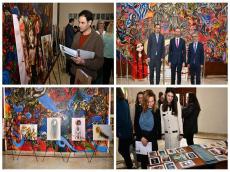
An exhibition themed "The Polish Puppetry Art" has opened its doors in Baku.
Organized by the Polish Embassy in Azerbaijan in collaboration with the Azerbaijan Puppet Theatre, the exhibition has garnered significant interest among theatergoers.
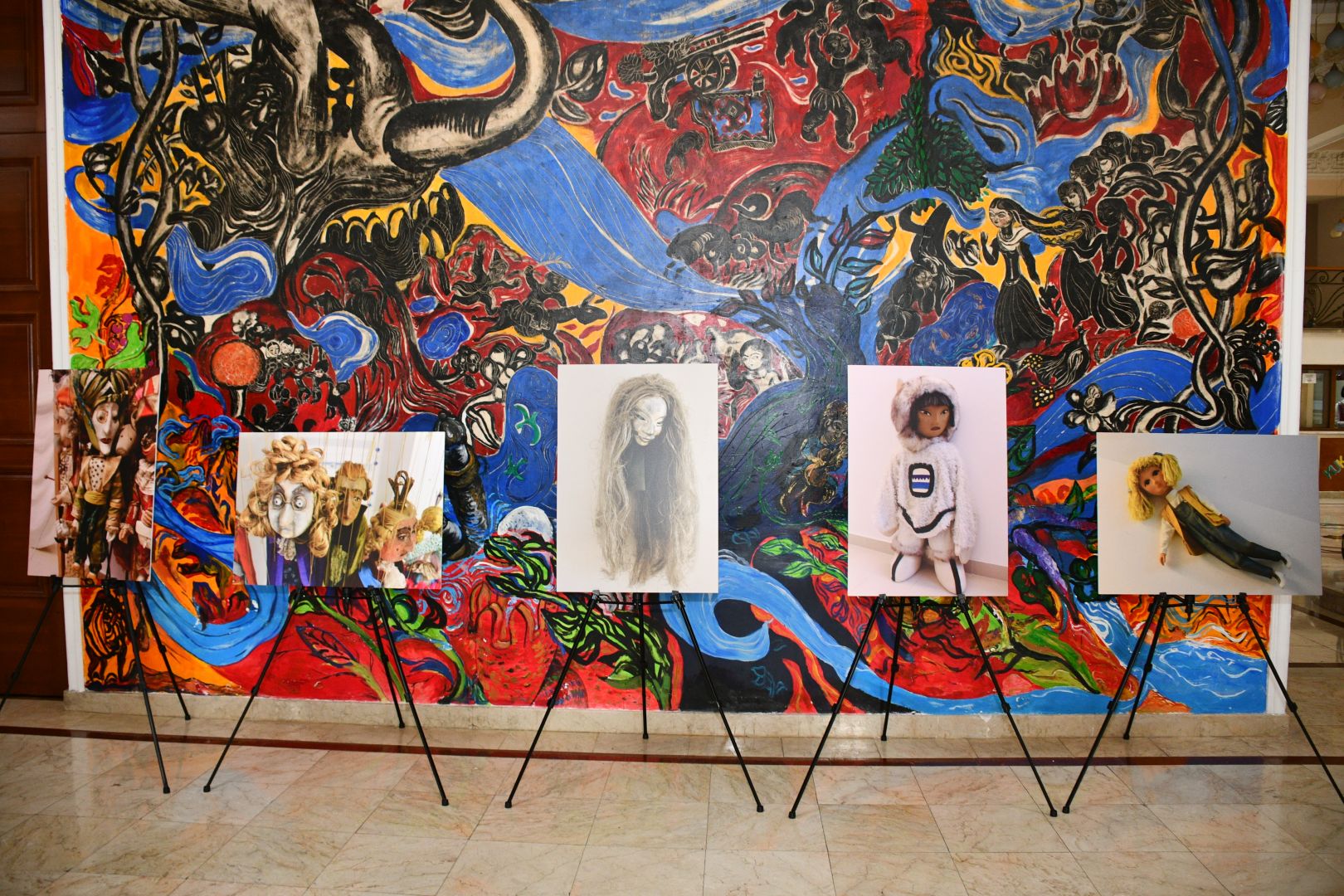
The exhibition is a cultural project and photo exhibition initiated by professional photographer and art curator Aydin Sadikhov.
Speaking with Azernews, the photographer said that his new photo project showcases 20 photographs captured in Poland's oldest and most renowned puppet theatres: Baj Theatre in Warsaw and Groteska Theatre in Krakow.
"This cultural project provides a unique opportunity to get acquainted with the interesting history and development of Polish puppetry art. The project makes it possible to immerse yourself in the magical world of Polish puppet theatres. This is a fairytale-like journey with beloved cartoon characters, dragons, witches, fairies, book heroes, knights, and other magical creatures," the photographer said.
"Through the art of photography, I invite viewers to enjoy the rarest, historical, and handmade examples of the Polish puppets and feel the unique atmosphere inside the workshops of the renowned Polish puppet theatres, where the real theatre magic happens every day," he added.
The entrance to the exhibition hall was decorated with beautiful Polish dolls, wearing national Polish costumes. A stand with brochures, colorful cards, informing about the Polish Puppet Theatres, as well as two dolls, wearing Polish traditional costumes, was set up in the foyer.
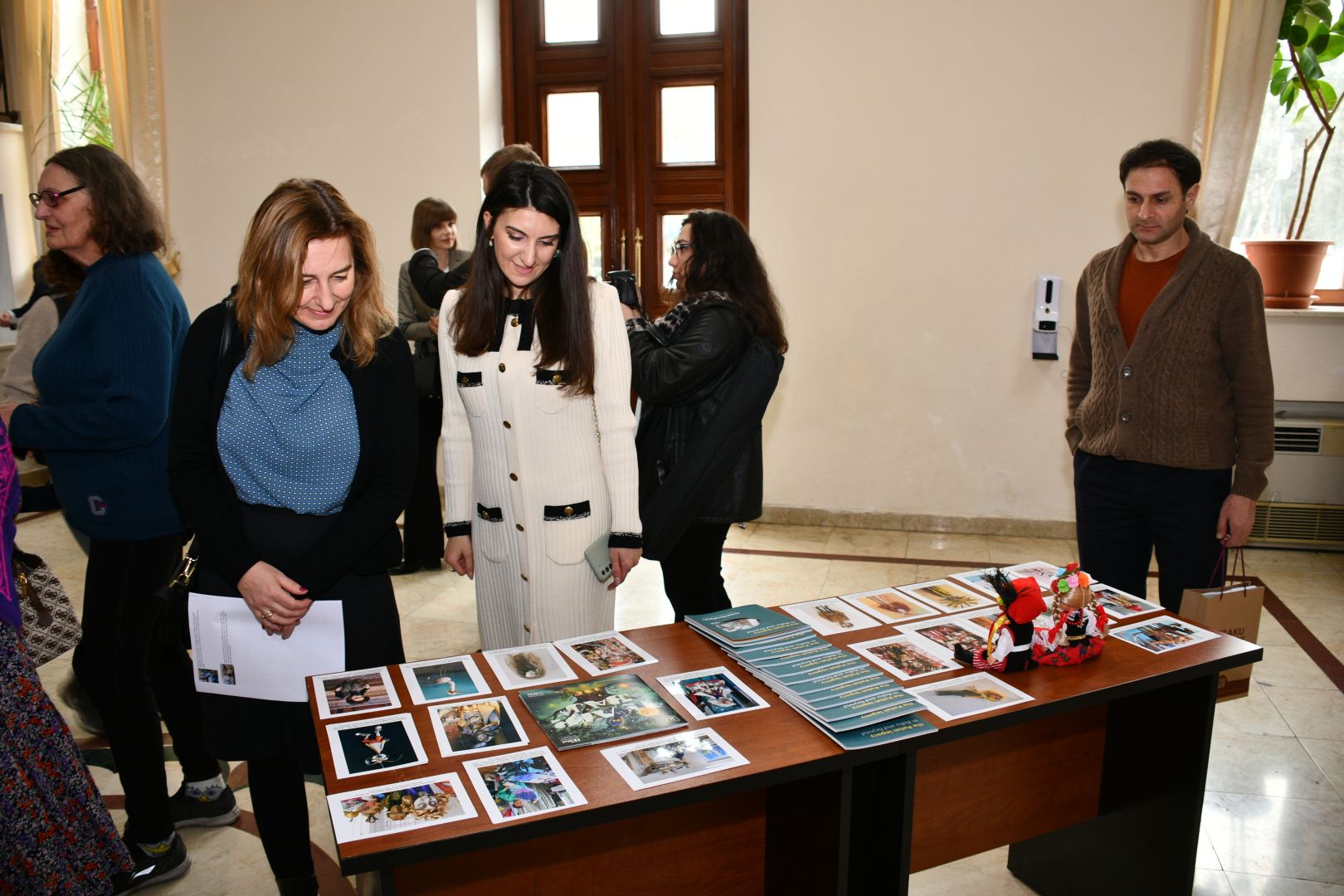
Representatives of different diplomatic corps, media representatives as well as cultural and art figures attended the opening ceremony of the exhibition.
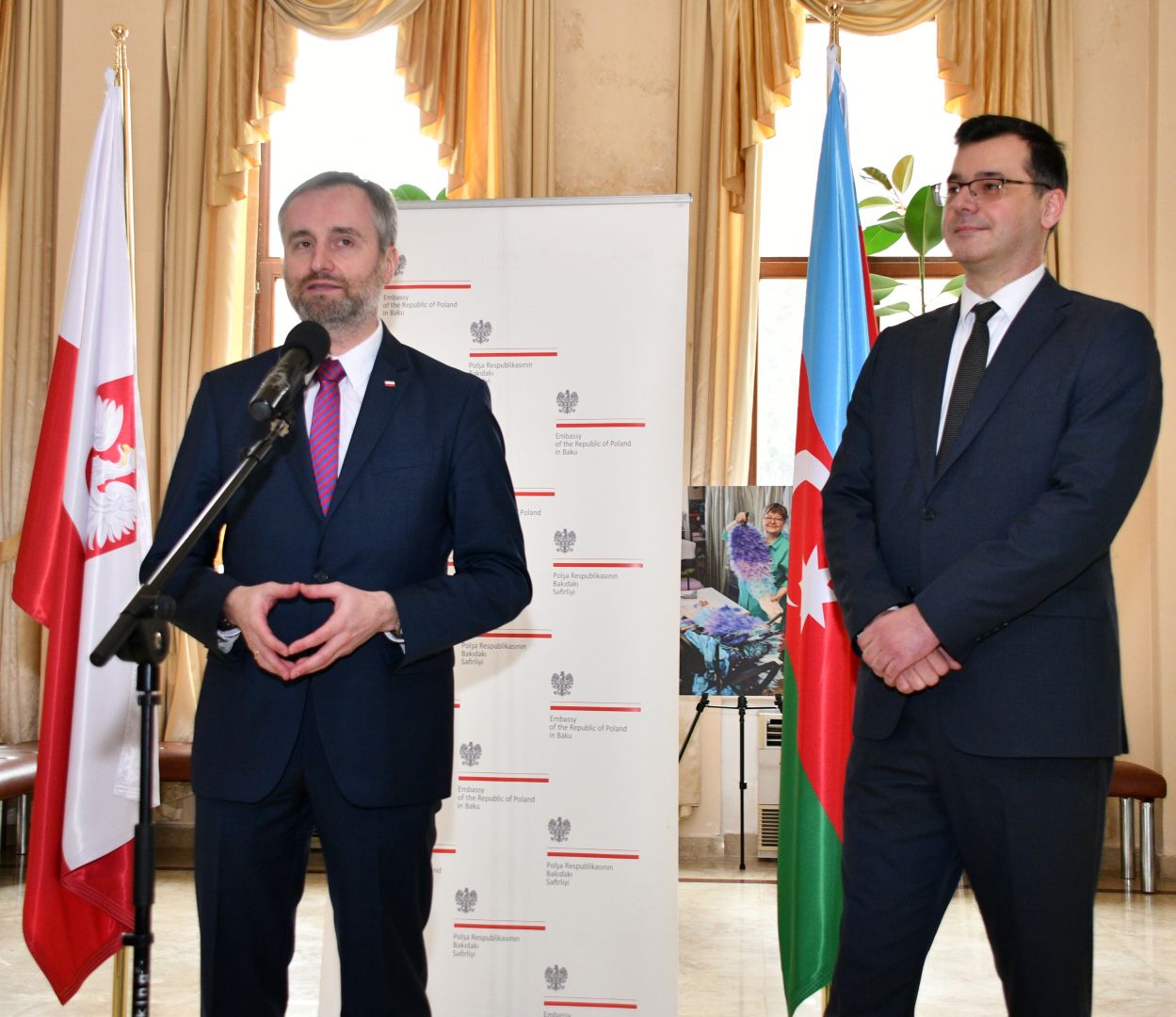
The Polish Ambassador to Azerbaijan Rafal Poborski welcomed the guests of the event.
In his speech, the Polish Ambassador to Azerbaijan Rafal Poborski hailed the cultural ties between the two countries, especially cooperation in theatrical art.
Expressing gratitude to partner organizations in connection with the exhibition, the Ambassador noted that such events contribute to cooperation between Azerbaijan and Poland in the fields of culture, theatre, and art.
Rafal Poborski outlined that Polish puppetry art has a centuries-old history. He added that there are numerous state and independent puppet theatre teams in Poland that preserve different artistic traditions.
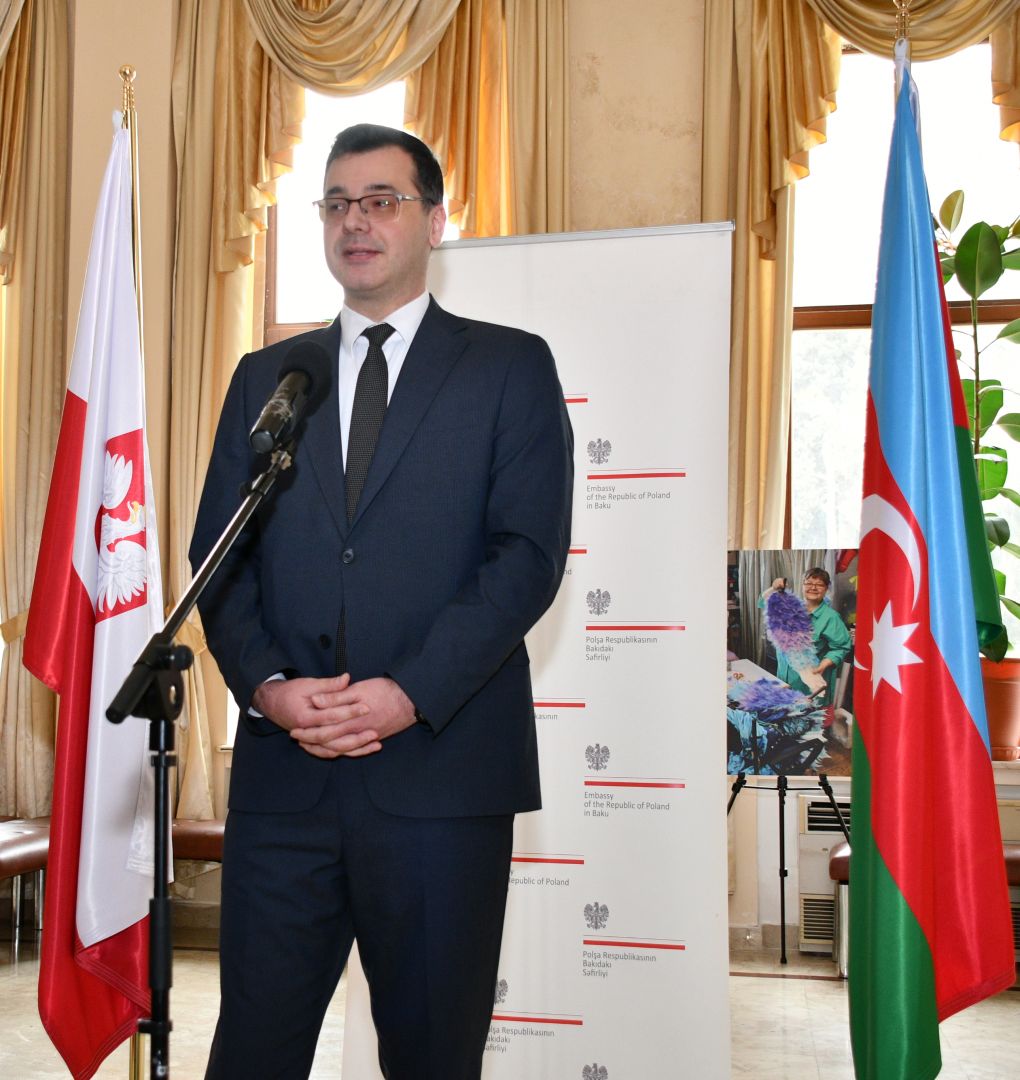
The Advisor to the Azerbaijan Culture Minister Oleg Amirbayov stressed that the exhibition is a great opportunity to get acquainted with Polish theatrical and puppetry art.
Saying that theatre has a unifying power as the most universal and effective form of creativity, he emphasized the importance of cooperation in the field of culture and art.
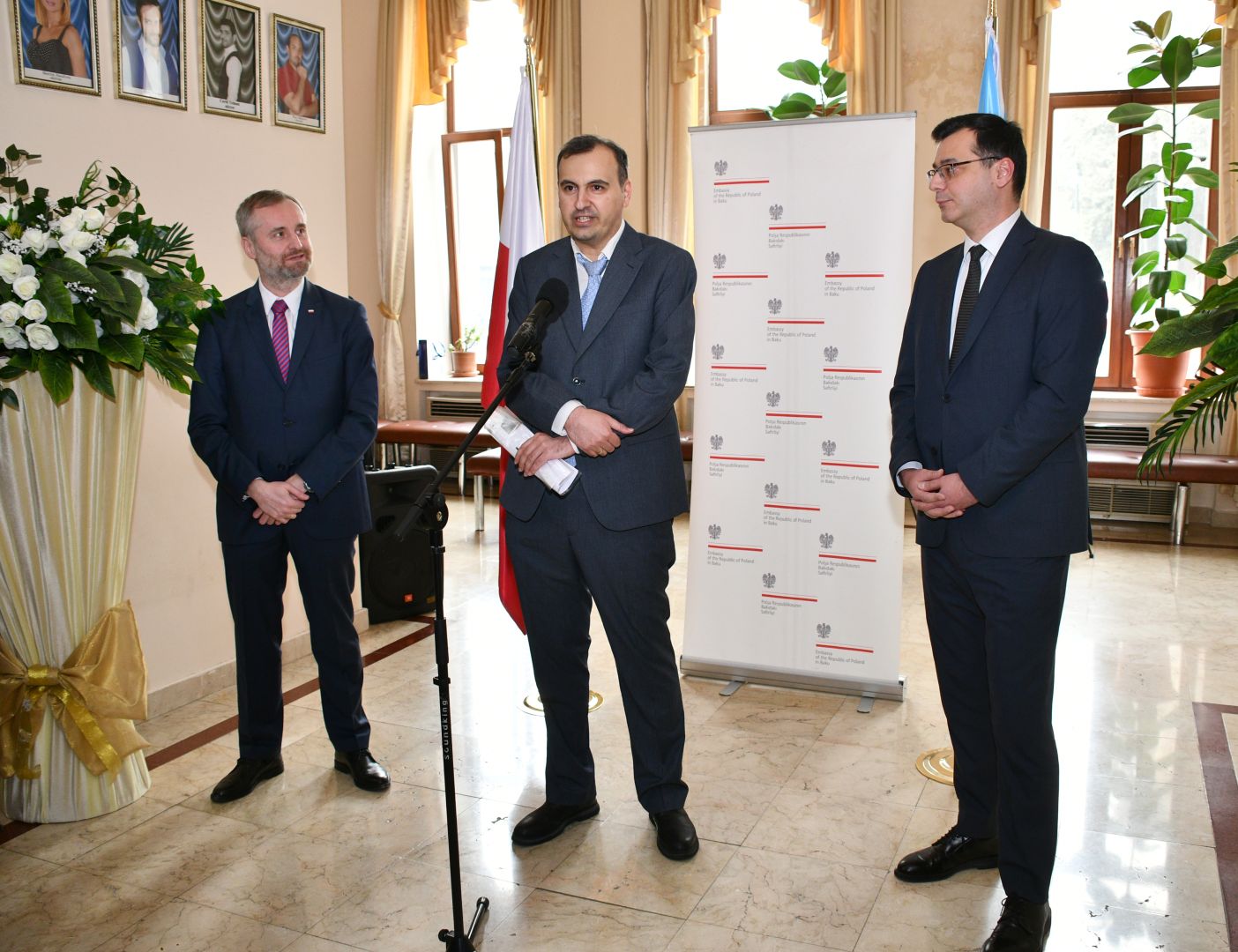
After official part, the project curator and photographer Aydin Sadikhov briefed the guests of the ceremony about the photographs showcased as part of the exhibition.
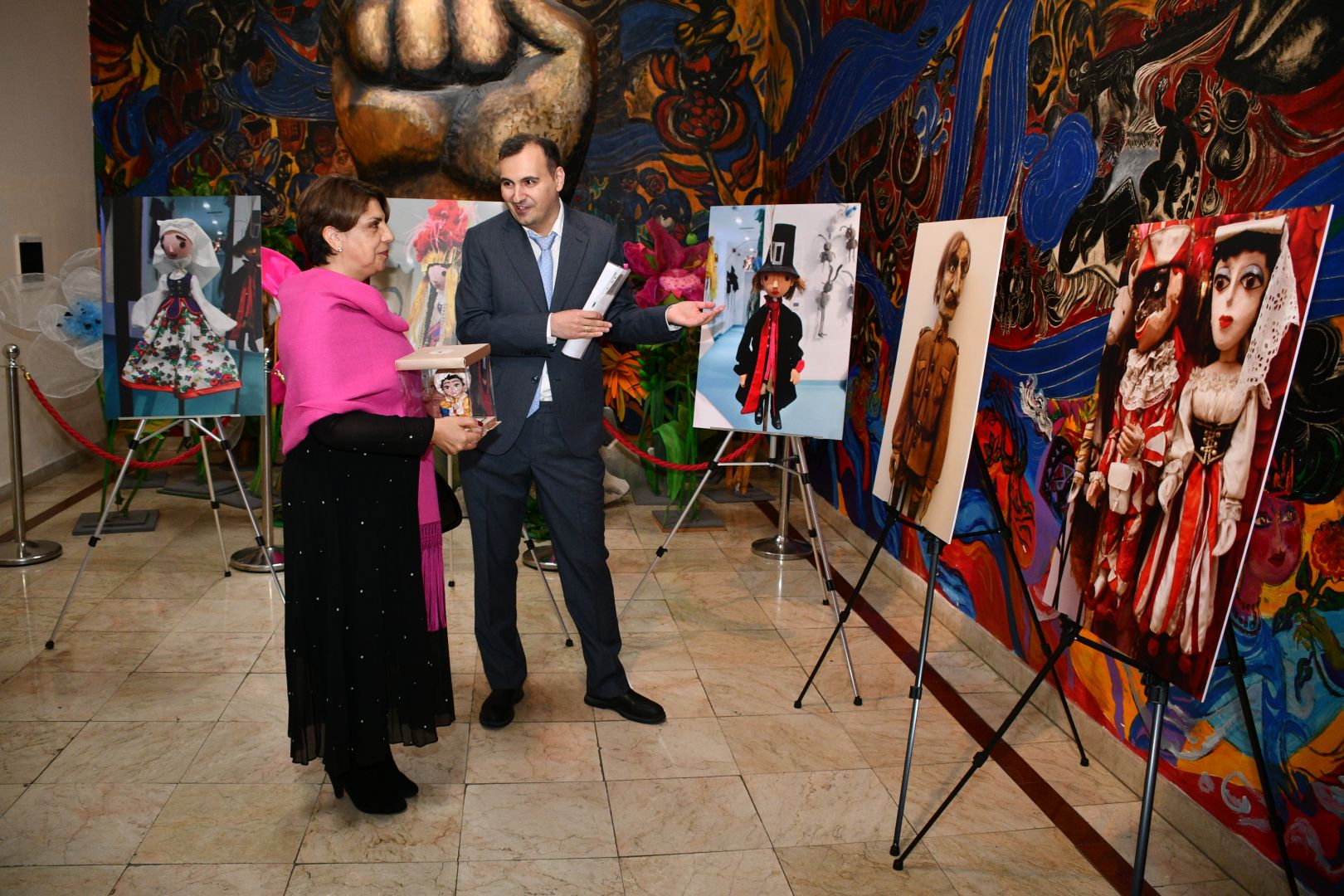
All guests of the event were briefed about the history behind each puppet photographed by Aydin Sadikhov.
He also introduces the photos of the theatres' workshops and describes the magical atmosphere that was there.
"Dolls and puppets are important parts of world culture. Being a kind of portrait of the international culture, the dolls and puppets show the history, development, and values of the culture of different nations. The doll and puppet, being part of the culture of all mankind, retains in its image the features of the nation creating it. The main value of the national doll and puppet is in this," said Aydin Sadikhov.
"It is very important to mention the huge role of the puppets in the development of international theatrical art. Theatrical puppets could be human figures, animals, or birds, as well as "animate ", or "talking " trees, flowers, fantasy characters of different fairy tales etc. Puppets are made from different materials. They "come to life" with the help of the actions of puppeteer actors.
He noted that theatrical stage puppets have their names: marionettes, puppets, glove puppets (placed on the hand), stick puppets, shadow puppets that project shadows onto the screen, etc. In theatrical performances there are also such puppets that move with electronic devices; these puppet actors are called "robot puppets". Puppet theatrical art plays a huge role in the development of the global culture because puppetry imbibes elements of all art forms such as literature, painting, sculpture, music, dance, drama, and enables people to develop their creative abilities.
At the end of the event, the director of the Azerbaijan State Puppet Theatre Rashad Ahmadzade presented the guests with beautiful memorable gifts.
Note that Poland has a long and interesting history of the formation and development of national puppetry and theatrical art.
Puppet theatre has existed in Poland for at least five centuries. The first documentary evidence dates from the 15th century and mentions puppet performers, which traveled through the country with their puppet shows. The artists of that theatre exhibited their puppet figures and presented puppet performances on the streets and main squares of the different cities of Poland.
Their shows included many artistically sculpted and finely costumed puppets, clever lighting, and a fine collection of stage machinery which allowed changes of setting in full view with many special effects. In the second half of the 18th century puppet shows multiplied in Poland, probably due to the support offered them by Stanislas Auguste Poniatowski, the last king of Poland, sympathetic to the arts in general including puppetry to which he gave his big support.
He attended the ever growing number of puppet performances, some given in large public spaces. A painting by Jan Piotr Norblin, "The Polish Marionettes", constitutes the first known iconographic document of the Polish puppet theatre. The painting shows puppet-actors, holding their control figures of the marionette type.
Poland is one of the leading European countries for the highest level in the development of Puppetry Theatrical Art. Proof of this is the fact that almost every city in Poland has its own puppet theatres. Creative teams of different puppet theatres in Warsaw, Krakow, Lodz, Szczecin, Olsztyn, Torun, Bialystok, Wroclaw, Opole, Slupsk, Lomza, Lublin, Walbrzych and from other cities of Poland - every day delights its guests with the absolutely magnificent and colorful performances. The plays are designed for all age groups, so both children and adult visitors get the opportunity to enjoy watching the interesting programs presented by these wonderful theatres. Each year, different Polish cities - Opole, Torun, Bialystok, and others host large Polish and International Puppet Theatre Festivals. The Polish Festival of Puppet Theatres, which has been held since 1962, is one of the most important and ambitious Polish festivals devoted to puppet theatre.
Baj Theatre is the oldest children's puppet theatre in Poland. It was founded in 1928 in the Zoliborz district of Warsaw, Poland. Its current name, Baj, was forged in 1930. The form and techniques used in the first plays took inspiration from a nativity scene, which is a traditional Christmas performance with puppets. The Theatre also organized puppetry classes all around Poland, popularising this type of theatre throughout the country. Many remarkable Polish artists and writers were engaged in the Theatre's activities, including Szczepan Baczy?ski, and Maria Kownacka. The Theatre has won numerous awards. Shows of the Theatre were presented at various festivals and competitions and during many guest performances. In recent years, actors in the Theatre have been traveling all around the world, presenting their amazing theatrical performances.
Additionally, as an institution, the Theatre focuses on supporting, developing, promoting, and popularising theatrical work as well as finding new ways to grow. Apart from creating shows, Baj Theatre is engaged in various theatrical and educational undertakings and running educational programs for schools and kindergartens.
The Baj Theatre has an amazing Puppet Gallery inside their building, where it is possible to acquaint yourself with the oldest historical and modern puppets that took part in different theatrical plays of the theatre. The curator of the Gallery and also creator of the most presented puppets of the theatre, Mr. ?ukasz Kuczy?ski holds the informative puppet tours there and shares with him interesting historical facts about all puppets.
Groteska Theatre in Krakow is one of the oldest and most renowned puppet stages in Poland. The theatre was founded in 1945 by outstanding theatre artists Zofia and W?adys?aw Jarem - directors, stage designers, and pioneers of modern thinking about puppet art and visual theatre. From the very beginning, the artistic vision of the theatre was co-created by outstanding artists, including Kazimierz Mikulski, Jerzy Skar?y?ski, and Lidia Minticz. Groteska directs its performances to multi-generational audiences. Performances for children and teenagers are characterized not only by interesting themes, and carefully selected repertoire based on outstanding literature, but also by top-class aesthetics using many forms of theatrical expression: a live set, puppets with various animation techniques, masks, costumes, and multimedia. The creators also attach importance to the musical aspect of the performances, enriching their shows with numerous songs that are easy to listen to, but also have a moral. Scenes for Children's performances are often based on classics. The Theatre's repertoire includes performances that are stage adaptations of famous fairy tales. Many outstanding directors, set designers and composers currently cooperate with the theatre. Grotesque enjoys great interest and audience attendance.
The theatre performs approximately 500 performances annually, watched by nearly 100,000 people. Recognition for the high artistic level of the Groteska Theatre is expressed not only by attendance but also by awards won at theatre festivals and in audience polls.
Since 2000, in June every year, Groteska Theatre has been organizing the Great Dragon Parade, a great dragon festival addressed to the mass audience.
The extremely spectacular outdoor light and sound show on the Vistula River at the foot of Wawel Castle, featuring huge dragons floating in the air and animated on speeding shoulders, is very popular and is watched by approximately 70,000 people. viewers.
URL: http://www.today.az/news/entertainment/246057.html
 Print version
Print version
Connect with us. Get latest news and updates.
See Also
- 25 September 2025 [15:42]
World premiere of ballet 'Two Carpets' based on Azerbaijani legend to take place in Astana - 25 September 2025 [11:43]
Azerbaijan represented at Moldova's Ethnocultural Festival - 25 September 2025 [10:36]
Ballet 'Epic of Nasimi' presented at Nasimi Gardens Complex - 24 September 2025 [12:21]
Sumgayit holds gala concert within Uzeyir Hajibayli Int'l Music Festival - 24 September 2025 [10:53]
Founder and head of IDEA Public Union Leyla Aliyeva and Arzu Aliyeva visit Museum of Modern Art in New York - 23 September 2025 [15:36]
National artist's exhibition opens in Prague - 23 September 2025 [14:22]
Sabina Zadeh steals spotlight at Silk Way Star Vocal Competition - 23 September 2025 [12:35]
Nasimi Festival kicks off in Heydar Aliyev Center - 23 September 2025 [12:28]
8th Turkish Film Days to be held in Baku - 23 September 2025 [10:17]
Founder and Head of IDEA Leyla Aliyeva and Arzu Aliyeva participate in Treasures Behind Doors of Anatolia exhibition in New York
Most Popular
 Baku and Beijing are making "green" plans
Baku and Beijing are making "green" plans
 Azerbaijan, Qatar explore joint investment and strategic sector cooperation
Azerbaijan, Qatar explore joint investment and strategic sector cooperation
 From hero to silence, the fate of Bagrat Galstanyan in the Armenian opposition
From hero to silence, the fate of Bagrat Galstanyan in the Armenian opposition
 Cooperation between Azerbaijan, Saudi Arabia in energy sector reached new level - President
Cooperation between Azerbaijan, Saudi Arabia in energy sector reached new level - President
 Azerbaijani, Armenian foreign ministers meet at UN in New York
Azerbaijani, Armenian foreign ministers meet at UN in New York
 Azerbaijan prepares bill on paid paternity leave
Azerbaijan prepares bill on paid paternity leave
 President Ilham Aliyev sends congratulatory letter to King of Saudi Arabia
President Ilham Aliyev sends congratulatory letter to King of Saudi Arabia
